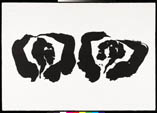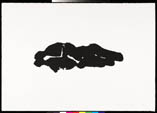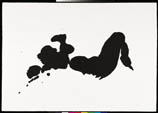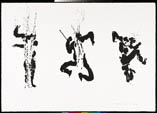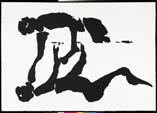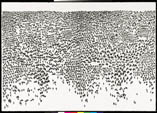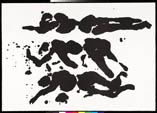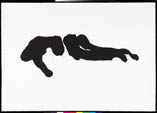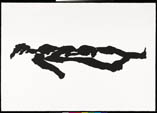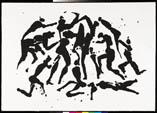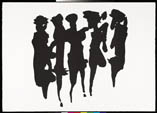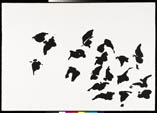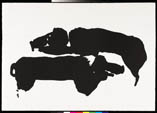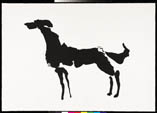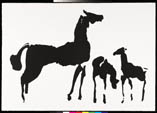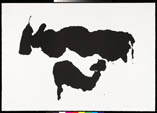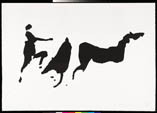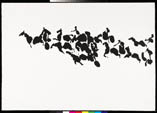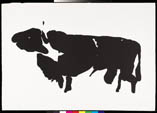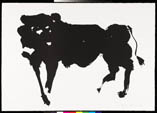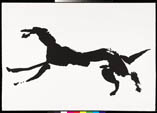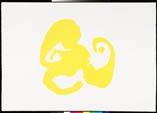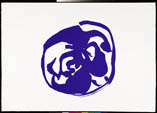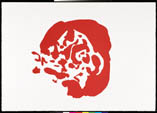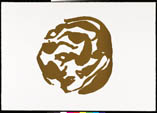exhibition programme | paintings | tapestries | prints | chronology of a life | market | biography & bibliography | agents | news
The Táin lithographs, 1969
PORTFOLIO EDITION, CONSISTING OF THREE SETS OF TWELVE LITHOGRAPHIC BRUSH DRAWINGS ON SWIFTBROOK, 54 x 38 (38 x 54) CM EACH, ED. 70 (1 ARTIST PROOF)
In 1967 the artist is commissioned by the publisher Liam Miller to illustrate Thomas Kinsella's inspired version of The Táin Bó Cuailnge, the dramatic record of Ireland's proto-historic past. Ailbhe Ní Bhriain notes: 'The Táin Bó Cuailnge - táin, meaning the gathering of people for a cattle raid - is a prose epic with verse passages and forms the centrepiece of the cycle of Ulster heroic stories. It tells of the exploits of King Conchobar and his chief warrior Cúchulainn ("The Hound of Ulster") and of the invasion of Ulster by Queen Medb of Connacht in an attempt to capture the Brown Bull of Cuailgne. Dating as far back as the twelfth century in manuscript form, this legend has been treated both academically by scholars and linguists and romantically by such Revival writers as Yeats and Lady Gregory. The Dolmen Edition of the saga was to give, in Kinsella's words, the first "living version of the story", a version true to its blunt and brutal Gaelic character.' Paints several hundred calligraphic brush drawings over a period of six months. The artist notes: 'Any graphic accompaniment to a story which owes its existence to the memory and concern of a people over some twelve hundred years, should decently be as impersonal as possible. The illustrations of early Celtic manuscripts express not personality but temperament. They provide not graphic comment on the text but an extension of it. Their means are not available to us today - either temperamentally or technically - but certain lessons may be learned from them relevant to the present work. In particular they suggest that graphic images, if any, should grow spontaneously and even physically from the matter of the printed text. If these images - these marks in printer's ink - form an extension to Kinsella's Táin, they are a humble one. It is as shadows thrown by the text that they derive their substance.' The illustrations will establish le Brocquy's reputation as an intrepretive draftman of considerable originality. Thomas Kinsella will give this assessment of his collaborator: 'There are certain staying qualities that help an artist to major achievement. The gift of concentration is one (in the sense of economy as well as of intensity), and so is steady energy. Le Brocquy has these qualities to a degree unique among Irish painters or designers since the death of Jack B. Yeats. He also has that individual force, stemming from tireless curiosity, which gives coherence to a career - the kind of force that insists on artistic growth, or change, and ensures that any stimulus, however seemingly random, finds a central response.'
Publication of The Tain, The Dolmen Press, Dublin (September 1969). Widely acknowledged as the great Irish Livre d'Artiste of the twentieth century, Seamus Heaney writes in The Listener: 'The book is illustrated lavishly and magnificently by Louis le Brocquy: "marks in printer's ink", he calls his contribution, "shadows thrown bt the text". Sometimes they are runs, sometimes a rush of brush strokes, sometimes a tall totem in the margin. The remote significance of the story, the bold vigour among the ranks of heroes and the wily, sexual presence of the woman are continuously insinuated by the graphic commentary. Altogether the poetry, painting and printing make this an important book, the fulfilment of a publishing dream.'179 le Brocquy's illustrations receive critical acclaim for their level of interplay with Kinsella's writing. According to Aidan Dunne: 'The brush drawings merged seamlessly with the text; stark, fluent images, they expressed with great economy of means an epic breadth, evoking the mouvement of vast masses of people. Individual participants in the drama were also pulled into close focus. To achieve this, le Brocquy developed his brilliant idiom of calligraphic illustration ... Le Brocquy's achievement lies in having absorbed the general technical possibilities and harnessed them to his own specific ends, and, in the process, having managed to break new ground. The Táin drawings managed a well-nigh perfect marriage of text and image, and their impact was considerable.'
Ailbhe Ní Bhriain further observes: 'The strong linear quality of le Brocquy's illustrations coheres with the upright, unfussy Pilgrim font, which is also suited to the direct tone of Kinsella's translation. The lettering, or initial letter, plays an important function in the livre d'artiste, and it can be seen here as a strong integrating element, as it is applied to the initial word of each tale. The bold font of the lettering echoes the dense black of le Brocquy's images, creating a fine balance between the literary and the visual symbol. These formal elements make it clear that The Tain is a production of carefully choreographed visual information, one comparable with the unity of Verlaine's language, Bonnard's arabesques, and the floral font in Parallèlement ... In his Tain illustrations, the ability of le Brocquy's drawings to emerge and dissolve gives fitting expression to the peculiar marriage of mysticism and raw physicality contained in Kinsella's text. Like gestures of primeval fear, strength, or passion, the "explosive" energy of the brushwork captures the physical exuberance of the text, as can be seen in the images of "bodily matters" and of violence, as in the several drawings of Cúchulainn's "warp spasm". Exhibition at the Dawson Gallery, Dublin (October 1969): The Táin portfolios, thirty-six black & white lithographs, five individual sheets, and four chromolithographic 'Shields' (1969; ed. 70), including The boy Cúchulainn armed (1969), The bull of Cuailnge (1969), Leaping wolfhound (1969), Cúchulainn confronting Ferdia (1969), Medb relieving herself (1969), Army massing (1969). Brian Fallon writes in the Irish Times: 'The Kinsella-Le Brocquy Tain was a stunner in terms of book production, a triumph for Liam Miller and the Dolmen, and a high-water mark in Irish publishing ... The result is very impressive, I should say one of the very best things Le Brocquy has done. It will be impossible from now on to think of the Irish Iliad in terms of the pseudo-medieval clutter of the old-style illustrations - helmeted warriors laden with "props" and looking rather like understudies for a Wagner opera. Le Brocquy's conception is epic, stark and primitive, at times even sinister (as in the superb "Morrigan"). In an idiom that can take in its stride hints from oriental art, cave painting, Picasso and other sources he has created powerfully and economically an entire mythico-legendary world.'
The Táin. Portfolios, consisting of three different sets of twelve black and white lithographic brush drawings. Five 'Individual Subjects' and four chromo-lithographic 'Epic Shields' separate. Limited edition of 70 proofs (1 artist's proof), each sheet individually signed, dated and numbered by the artist - including portfolio numbers (I, II, & III). Printed by Frank O'Reilly, Dublin, on Swiftbrook paper, each sheet 54 x 38 (38 x 54) cm. Large folio, unbound. Boxed by Museum Bookbinders, Dublin, black boards stamped in white in a design by the artist.
